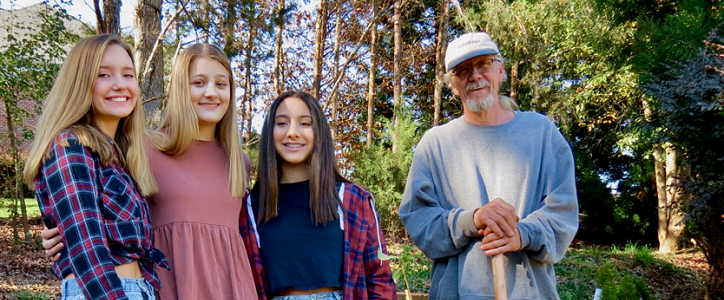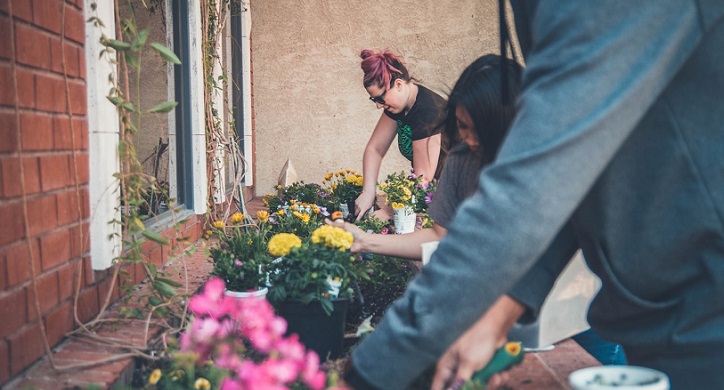On the run? LISTEN to our post!
When Steve Hall bought his 43 acres of farmland in the Appalachian foothills more than a decade ago, he quickly discovered the difference between his dreams and farming reality. The land wasn’t as productive as he had hoped. “More rocks than dirt, really,” he remembers. But he talked with knowledgeable local producers. He sought out experts. He experimented, observed, and learned.
And in the intervening years, a lot has changed – the productivity of his land, and the attitudes of a lot of people who think and act like Steve.
Moving Beyond Gardening
Today, Steve and his two sons operate “Hall’s Regenerative Agriculture”, a consulting company that provides hands-on help for an increasing number of home farmers from the city, suburbs, and elsewhere on how to make their own contribution to the growing focus on sustainability and regenerative practices.

Colin Hall (left) and his father, Steve Hall, work with an expanding roster of clients to apply basic regenerative ag principles to home landscaping and gardening. Photo courtesy of Sonya Mull.
“I’ve worked with bank presidents and average homeowners,” Steve notes. “But they all seem to want the same thing – to use whatever space they have responsibly, not just to look nice or produce a little food. They want to feel like they are doing something worthwhile for the earth we all share.”
Steve has helped clients with as little as one-tenth of an acre, to some with dozens of acres, or more. “I help some folks in rural areas,” he observes, “but more and more it’s people in the suburbs, and even some in the city. It’s about the attitude and awareness people have of our world and our environment, more than how much land they have to work with.”
“The interest in this isn’t really so much a flood as a rising tide,” he notes.
Most of his clients, he says, look for diversity in plants, trees, and other growing things that not just produce some food but maintain the health of the larger ecosystem. “You see some strange combinations sometimes,” he adds. “You want perennials that come back year after year, giving up something edible but also co-existing with each other to replenish the ground and maintain a healthy balance.”
Making the right choices can mean having food from your own land “nine, and maybe even ten, months of the year in this area,” he notes. Maybe just as important, some of these planting configurations will continue to generate environmental benefits that span 50 to 70 years – and maybe more.
On this day, his clients are Ted and Sonya Mull, and their son Connor and daughter Avery. Ted is a medical doctor, his wife a nurse, and his kids two typical suburban high school students. They contacted Steve after realizing their plans to do some landscaping improvements could have a lot more than cosmetic value.
Short-Term Work for Long-Term Results
“It dawned on all of us that what we were doing was more important than just planting a few bushes, or getting our garden plans in order,” Ted reflects. “Maybe it was the effect of being locked away and having so much time to reflect. But we saw a chance to do something more important – something that mattered a lot more than how our place looked.”
Adopting the regenerative approach to home landscaping and gardening led to the addition of a wide variety of plants, all with beneficial environmental qualities.
Making their own small contribution to a healthy and sustainable environment was just the starting point, according to both parents. Ted explains, “Today, it’s so easy for us to forget what it takes to produce the food we eat every day.” He continues:
“We don’t see the effort and the expertise that goes into growing the food we need. Doing this helped remind the kids exactly what it takes to produce food. It teaches them about how connected we all are to the earth and how important it is to make sure we keep that earth healthy and thriving.”
“Covid has been tough on all of us,” Sonya adds. “There’s the isolation and distance from other people, of course. But for kids, there’s also the sense that things are out of control, that the future isn’t what it once seemed to be. Doing this has helped them see a kind of regeneration through nature. We’re doing things that speak to the future – a better future. It sounds kind of like Mary Poppins or something that usually will make teenagers roll their eyes. But they have gotten into this. It’s been great for them. For all of us.”
 Avery, in fact, soon enlisted friends from school to be part of the regenerative project. Together, they planted trees, shrubs, and other growing things. And as they did so, they talked with Steve, and they learned about the environmental value of the things they planted.
Avery, in fact, soon enlisted friends from school to be part of the regenerative project. Together, they planted trees, shrubs, and other growing things. And as they did so, they talked with Steve, and they learned about the environmental value of the things they planted.
The mix of plants and trees proved to be more diverse than anyone had considered. Beyond the usual suspects of cucumbers, carrots, tomatoes, and other backyard garden staples, Steve advocates lots of berries – currants, goji berries, sunchokes, pawpaws, and more. Black walnut, pecan, maple, apricot trees — “and lots and lots of blueberry plants and apple trees,” Steve adds with a hearty laugh. “People love those, they are good for you, and they are critical to balance in so many situations.”
To the right: Avery Mull, Gabby Sutcliffe and Sarah Katy found that a home landscaping project could be valuable both to a sustainable local environment and their own understanding of regenerative agriculture. Photo courtesy of Sonya Mull.
Every situation is different and demands some thinking and careful planning. “The big thing is to understand how all different types of growing things interact with each other and the world around them,” Steve notes. “It’s a dance…planting the right things in the right places and treating them right. It’s thinking not just about right now but what happens next.”
Steve’s parting advice? “Don’t just go stick some things in the ground and expect to get the results you want. Think about it. Do some research. Ask somebody who knows more than you do. What you are doing is important, so take the time to do it right.” He also provided some great tips to introduce regenerative ag in our backyards, no matter the size…
10 Simple Tips for Home Regenerators:
- Plant trees in pairs to promote effective pollination
- Always place taller plants to the north so smaller plants get the sunlight, too
- Use eco-friendly sun-blockers to control weeds (cardboard, hemp mats, cocoa mulch, burlap)
- Don’t skimp on nitrogen fixers (such as beans, clovers, and lupins)
- Consider investing in a simple device to monitor nutrient levels in your soil
- Diversify what and when you plant to help stagger your harvests
- Monitor your water use carefully to avoid overwatering and water waste
- Consult your local ag extension agent or gardening expert to find out what is right for your situation. Also, ask about micronutrient accelerators — plants that help gather micronutrients and minerals important to local soil replenishment.
- If you use commercial products to nurture or protect your plants, always follow label directions closely
- Observe what works well and what doesn’t. Take good notes and learn from them. Share them with your neighbors.
For a more comprehensive look at how to make your home gardening and landscaping more regenerative, check out this “Food Forest” article at Modern Farmer.




 Russell and Brandy work hard to make a go of it in the demanding world of cattle production. It’s hard work keeping tabs on the cattle 24/7, protecting them from predators, and doing it all in a way that preserves the delicate balance that protects the natural resources they and their predecessors have relied upon for more than a century. It’s a rugged life made even more so by dealing with desperate immigrants passing through.
Russell and Brandy work hard to make a go of it in the demanding world of cattle production. It’s hard work keeping tabs on the cattle 24/7, protecting them from predators, and doing it all in a way that preserves the delicate balance that protects the natural resources they and their predecessors have relied upon for more than a century. It’s a rugged life made even more so by dealing with desperate immigrants passing through.


 “Our extension services seek to answer real-life questions,” according to Dr. Gary Bates, director of the University’s Beef and Forage Center and associate professor of plant and soil science. It’s learning for the real world, not just a classroom or a course exam or even a dinner-table discussion.
“Our extension services seek to answer real-life questions,” according to Dr. Gary Bates, director of the University’s Beef and Forage Center and associate professor of plant and soil science. It’s learning for the real world, not just a classroom or a course exam or even a dinner-table discussion.
 “We’ve built our programs around the simple idea that if our state economy is going to be healthy, we have to have a healthy agricultural sector…we want everybody in the state to be able to benefit from that. Not just the men and women who produce agricultural products…we teach people how to get the most from that system, in how they choose the right foods, how they preserve food and avoid waste, how they prepare safe meals for their families, and on and on and on. We teach everyone how important it is to make the system truly sustainable.”
“We’ve built our programs around the simple idea that if our state economy is going to be healthy, we have to have a healthy agricultural sector…we want everybody in the state to be able to benefit from that. Not just the men and women who produce agricultural products…we teach people how to get the most from that system, in how they choose the right foods, how they preserve food and avoid waste, how they prepare safe meals for their families, and on and on and on. We teach everyone how important it is to make the system truly sustainable.”




